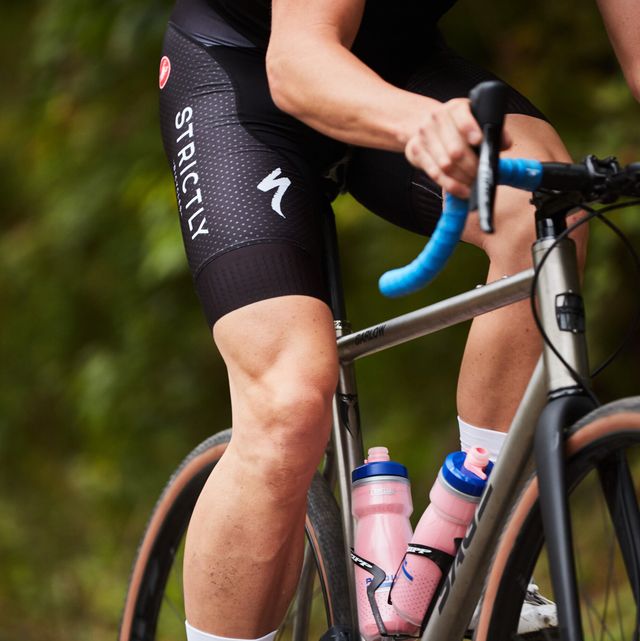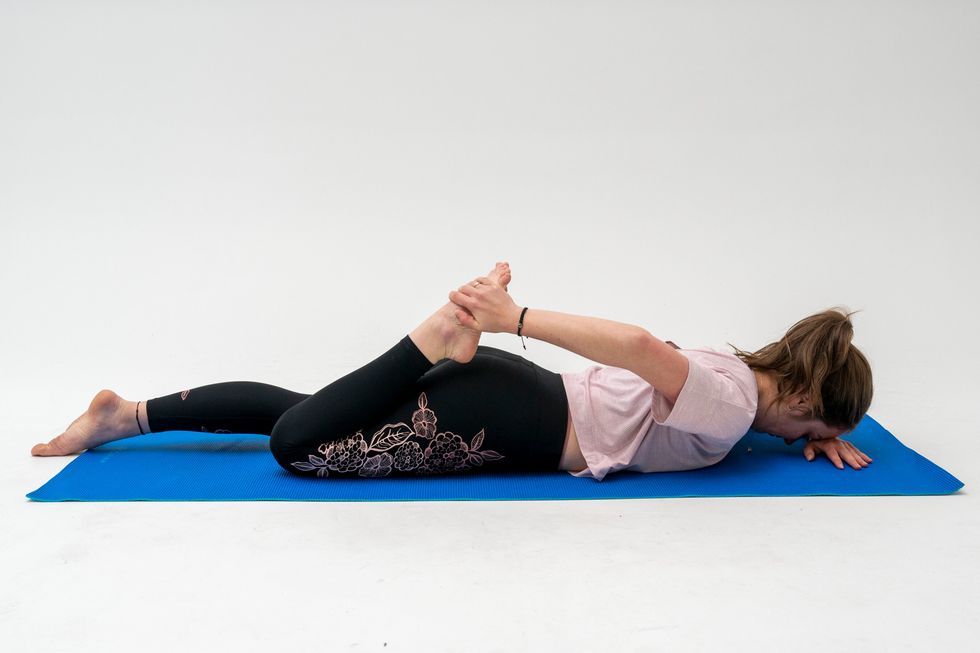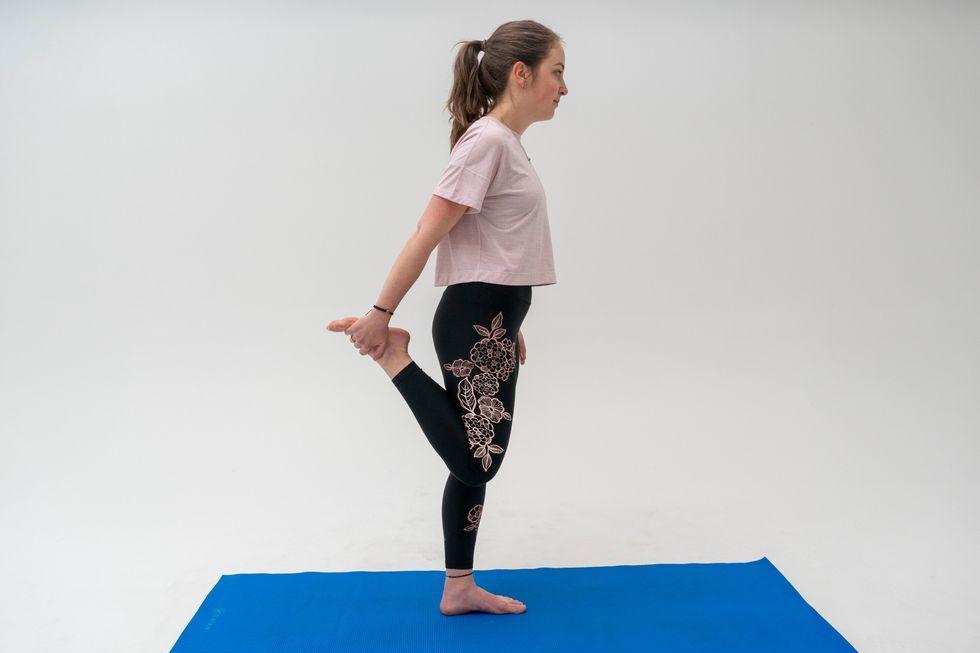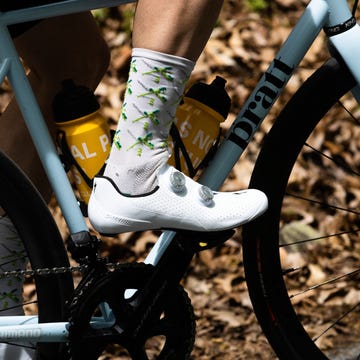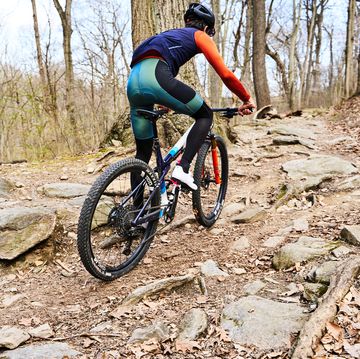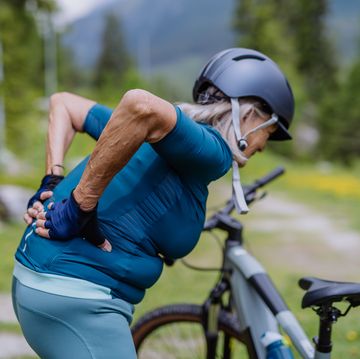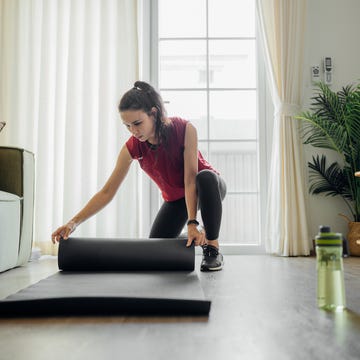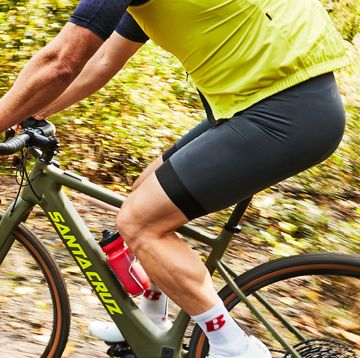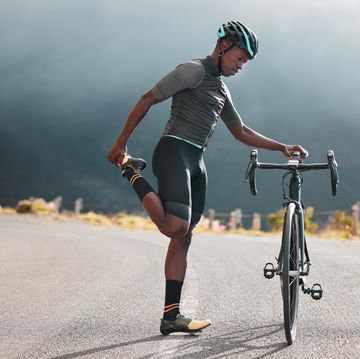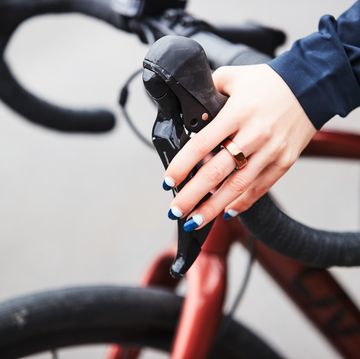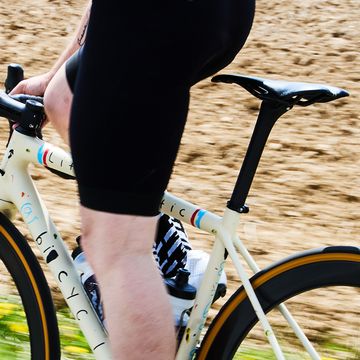In the cycling world, tight quads can be as ubiquitous as lycra, hill climbs, and midride PB&Js. “It’s very common for cyclists to experience tight quads,” Scott Capozza, P.T., M.S., an avid cyclist, Connecticut-based physical therapist and spokesperson for the American Physical Therapy Association, tells Bicycling.
The sensation of “tightness” in the quads can signal a few different things. One can be underlying inflammation in the muscles, or a buildup a lactic acid, caused by your body’s natural response to exercise, Craig Secor, P.T., D.P.T., a Richmond, Virginia-based physical therapist and bike fit specialist, tells Bicycling. It can also be due to the quad muscles themselves being held into a shortened position, or by bundles of muscle tissue that aren’t laying down straight (what you might think of as “knots”), he adds.
Regardless of what is driving your quads to feel tight, good news is that you don’t have to put up with them. In fact, continuing to pedal with stiff-feeling quads can hamper your performance and up your chances of pain and injury in surrounding areas, including the hips, back, and knees, Secor says.
“Muscles in general work better when they start in their natural, relaxed state,” he explains. “If a muscle at rest is already in a shortened position or just neuromuscularly isn’t being turned on as well due to inflammation, those muscles may not be as active as they should be.” And that can cause pain and performance inefficiencies, because instead of using your quads as a main power source for your pedal stroke, as is good form, you may start relying on other muscles to jump in for support.
With that in mind, we tapped Capozza and Secor for more intel on what causes cyclists to have tight quads and the best ways to relax stiff legs. Here’s all you need to know.
Common Causes of Tight Quads
1. Overuse
One main job of the quadriceps is to help with knee extension, which in cycling, occurs pretty much every time you push down on the pedals. Additionally, one of your four quad muscles—the rectus femoris—helps with hip flexion too, which is also a common motion in cycling, happening every time you drive your knee up towards your torso.
Because of this, cycling is considered a “very quad-dominant exercise,” Secor explains. It makes sense then that spending lots of time on a bike—and thus engaging your quads for minutes or even hours on end—can lead to these powerhouse muscles feeling stiff and achy. “When you work muscles like that over and over and over again, they tend to get tight and feel tight,” Secor explains.
2. Poor Bike Fit
Cycling is a really repetitive motion: You’re basically just moving your legs forward and backward in one plane of motion. So if the alignment of your bike is off, even just slightly, that can lead to tightness in the quads, Capozza explains.
Specifically, if your seat is positioned too high or too low, or if your seat pitch (basically, how high or low the nose of the seat is angled up or down) isn’t quite right, your quads can bear the brunt of that misalignment.
3. Weak Muscles
Your bike may be perfectly adjusted, but if your quads are weak, then that lack of strength can ultimately trigger a sensation of tightness, Capozza says. That’s because cycling, like we mentioned, is such a quad-dominant activity, so if your quad strength isn’t quite what it needs to be to support the activity, then spending time in the saddle will overload the muscle group, ultimately causing you to feel tightness.
The Best Ways to Find Relief for Tight Quads
Tight quads are no fun, but there are simple things you can do to remedy them. Here’s what the experts recommend.
1. Try Simple Stretches
Stretching tight quads can help relax and loosen stiff muscles. Do these moves, recommended by Secor, before and after your ride, as well as midway through—once your muscles are warm from pedaling, hop off the bike for a few minutes and bust out a round or two.
Hold each exercise for 30 seconds to one minute and repeat for one to three rounds total. You can also perform them outside of a workout whenever your quads are feeling tight. Just avoid overstretching—the moves should never feel painful; if they do, back off.
➥Prone Quad and Hip Flexor Stretch
Why it works: A standing quad stretch (see below) is the classic way to target this muscle group, but this prone variation (a.k.a. lying facedown) can be even more effective, as the non-weight bearing position helps your muscles relax more and the ground prevents your knee from drifting forward, a common mistake with this stretch, Secor explains.
Depending on your flexibility, you may need a strap to perform this move (a dog leash can also do the trick). There are two parts to this stretch: The first targets your quads as a whole, and the second specifically hits your rectus femoris (the quad responsible for hip flexion).
How to do it:
- Lie facedown with legs stretched out long, arms at sides.
- Grab right ankle with right hand, pulling it toward right glute. Make sure knee doesn’t flare out to the side but stays in line with body; right thigh should be parallel to the left.
- Hold for 30 seconds to 1 minute.
- If you can’t comfortably grab ankle with hand, place a strap around ankle, and holding both ends in hand, pull foot toward glute.
- Complete part two by placing a book or pillow under bent knee. Perform the stretch from here, holding for 30 seconds to 1 minute.
- Switch sides and repeat both parts of the stretch.
➥Standing Quad and Hip Flexor Stretch
Why it works: The prone quad stretch may be tough to bust out in a public setting, but this standing version can be performed pretty much anywhere, making it an easy addition to your routine. This stretch also contains two parts: The first hits your quads as a whole and the second hones in on your rectus femoris.
How to do it:
- Standing tall, grab right ankle and pull it toward right glute. Try to keep bent knee in line with body—don’t let it drift forward or flare out to the side. Engage glutes and core.
- Hold this position for 30 seconds to 1 minute. Feel free to rest non-working hand on a wall or nearby sturdy object if you need help with balance.
- Complete part two by pushing bent leg slightly behind body so that you feel a stretch at the front of hip; avoid arching the low back and instead think about tucking tailbone. If you struggle to avoid a low back arch, then stick with the prone version of this part of the stretch.
- Hold for 30 seconds to 1 minute. Switch sides and repeat both parts of the stretch.
2. Get a Professional Bike Fit
Because an ill-fitted bike can trigger tight quads, it may be worth your while to see a pro about your set-up if you haven’t already. “I am a big proponent of getting fit to your bike,” Capozza says.
Call around to local bike shops to see if they have a certified fitter on staff—even better if that person is also a physical therapist, as they’ll have even more knowledge and expertise to address tight quads by ensuring your ride is a perfect fit.
3. Consider Heating or Icing
If your quads are feeling tight in general, consider applying heat before your next ride to boost blood flow to the area. Capozza recommends reaching for a heating pad or pack versus a cream as the former will penetrate a little deeper toward your muscles.
After a ride, if your tight quads cause knee, hip, or low back pain, then apply ice to the achy areas to tamp down the inflammation, Capozza adds.
Just keep in mind: Though heat and ice can help achy muscles feel better, they shouldn’t become the go-to treatments for tight quads. If you find yourself frequently turning to hot or cold therapy to soothe the effects of tight quads, then “something’s got to change,” Secor says. Chances are, you’re pushing yourself too hard and should tone down your workouts and possibly check in with a PT to get to the root of your chronic tightness.
4. Incorporate Light Strength Work
Because tight quads can sometimes be a symptom of weak quads, strengthening this muscle group can ultimately help it feel less achy. Try the following exercise, from Capozza, to bolster your quads.
➥Sit to Stand
Why it works: This exercise, essentially a squat variation, is a simple way to work your quads without any equipment—all you need is a standard size chair.
How to do it:
- Stand tall with back to a chair and send hips back and down to sit down in the chair.
- Without holding onto the sides of the chair, stand back up. That’s 1 rep.
- Do 6 to 8 reps and repeat for 2 to 3 rounds total.
- To target one leg over the other, perform this exercise from a staggered stance position; when you stand up from the chair, the back leg will take on more work.
- As the move starts to feel easy, gradually increase the repetitions until you can do 2 to 3 sets of 15 reps. Once that’s a piece of cake, you’re ready for more advanced exercises.
5. Book a PT Appointment
If you’ve tried the above remedies and are still plagued by tight quads, then it’s probably time to visit a physical therapist. They can help identify muscle weaknesses or imbalances that may be contributing to your tight quads and prescribe an individualized program to help, Capozza explains. A physical therapist can also take a deeper dive to understand which part (or parts) of your quads are causing trouble.
“Often when we think of the quad, we think the quads are one muscle but the quad is actually made up of multiple muscles,” Capozza explains. (There are four quad muscles to be exact, hence the name “quad.”) Being able to pinpoint which specific muscles in the quads are tight can help you understand where you might benefit from stretching versus strengthening.
Other signs to check in with a PT include if your quad tightness lasts more than two weeks; if you’re feeling it acutely every day (for example, each morning you wake up and think “wow, my quads are really stiff”); if it’s causing pain in other areas, like your knees, back, or hips; or if tight quads are kiboshing your ability to ride or complete daily tasks, like going up and down stairs or getting in and out of the car, Capozza says.

Jenny is a health and fitness journalist. She’s also an NASM-certified personal trainer. Her work has been published by Vogue, Glamour, SELF, Outside, and Health, among others. She lives in Colorado, where she teaches water aerobics at her local rec center.
